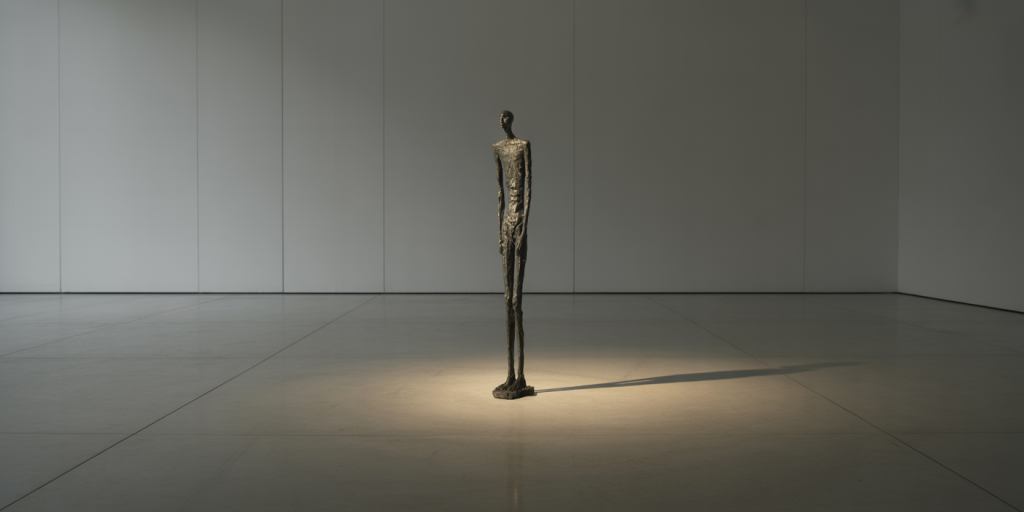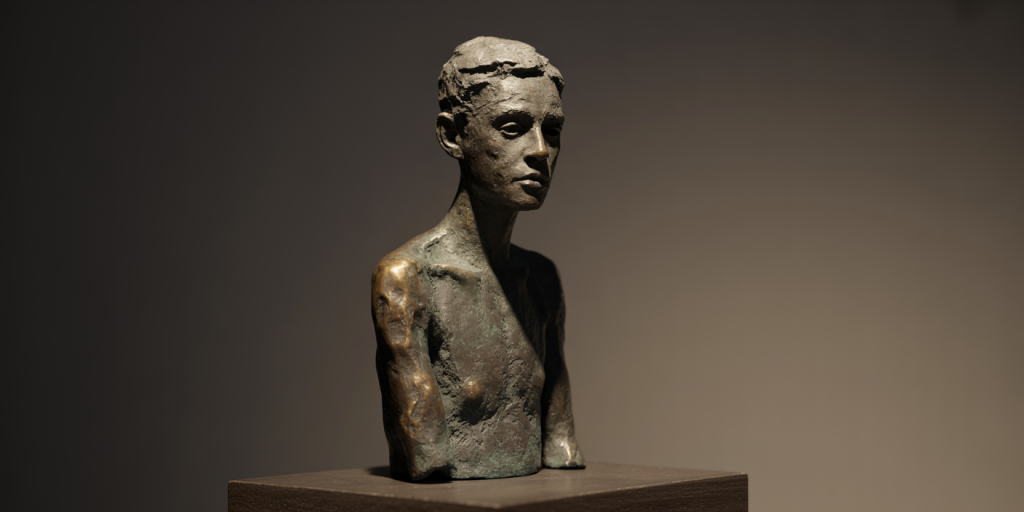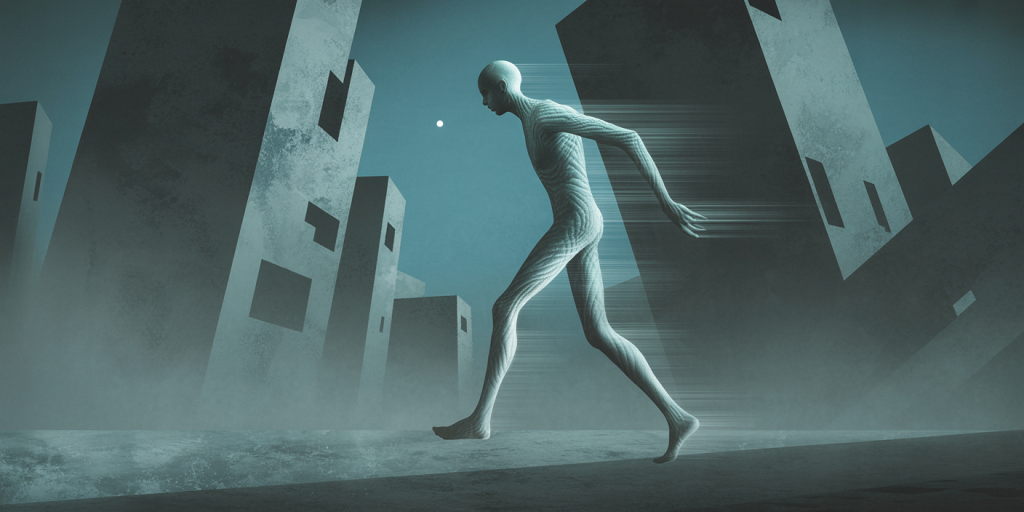In the Void Between Gestures – Giacometti and the Dance of Existence
Contemplative Opening
There is a silence that hovers in the space between gestures—a breath unspoken, a tension vibrating between presence and absence. In Alberto Giacometti’s hauntingly elongated sculptures, the human figure does not merely stand—it trembles within the void. Each fragment of bronze is a whisper of existential weight, each inch stretched toward the abyss of being. One does not look at Giacometti’s figures; one listens to their silence, feels the density of their loneliness as if time itself paused to witness their vulnerability.
The dance of existence, in Giacometti’s hands, becomes skeletal and spectral. There is no adornment, no flourish—only the raw tremor of life etched in fragile lines. To gaze upon his work is to confront not the shape of a man or woman, but the shape of doubt, of solitude, of survival. It is the soul, stripped of ornament, crossing the stage of the void with one delicate, determined gesture.
Summary
- Shadows that Stretch into Memory
- The Stillness that Screams
- A Body Etched by Absence
- Between Bronze and Breath
- The Sound of a Figure Moving Nowhere
- The Dust of Existence, Solidified
- Where Light Carves the Soul
- Echoes in the Shape of Man
- Limbs Like Questions
- The Vertical Tension of Being
- Erosion as Expression
- Texture that Trembles
- The Echo of Rodin in Hollow Bones
- The Weight of Emptiness
- Time Trapped in a Walk
- A Portrait Made of Ashes
- Solitude Cast in Bronze
- The Distance Between Us
- From Flesh to Essence
Shadows that Stretch into Memory
Giacometti’s sculptures appear as if pulled from a fading dream—figures so slender they verge on vanishing. They are shadows frozen in form, silhouettes carved from memory rather than matter. One sees not a person, but the echo of someone who once was, or perhaps still is—suspended between time and remembrance.
Their elongated limbs suggest not grace, but gravity—the kind that weighs the spirit. These shadows do not move, but the world moves through them, and in that stillness, memory stretches.
The Stillness that Screams
There is a scream inside Giacometti’s stillness. The figures stand erect, yet they quiver in their silence. They do not cry out, yet every texture of their surface seems to howl with the fatigue of living. This is not the stillness of peace—it is the stillness of endurance, of beings trapped within themselves.
Their posture is neither proud nor broken—it is resigned. This quiet posture communicates more than any dramatic gesture could: the persistent ache of existing in a world that offers no clear meaning.
A Body Etched by Absence
Where others sculpt fullness, Giacometti sculpts lack. His bodies are not shaped by muscle but by what is missing—hollows, grooves, the erosion of the expected. Each sculpture seems nibbled away by time, anxiety, or the gaze of eternity.
They are not incomplete—they are precisely as they must be. The absence becomes presence, and in every void, a story breathes. His figures are not worn out by life—they are defined by it.
Between Bronze and Breath
Though made of bronze, Giacometti’s figures breathe. There is a contradiction at play—metal that quivers, permanence that vibrates with ephemerality. The materiality of the work never overrides its spirit; instead, the bronze becomes a skin stretched taut over something fleeting.
His surfaces are rough, textured like bark or scars. The bronze is alive, almost unfinished, as though it were still trying to become human.

The Sound of a Figure Moving Nowhere
Many of Giacometti’s figures appear in motion—a walk arrested mid-stride. Yet their movement is circular, interior. They move but never arrive. It is the dance of the lost, the pilgrimage of self.
This eternal forwardness evokes the futility and beauty of the human condition. We walk not toward something, but through something—an invisible fog where identity reshapes itself with every step.
The Dust of Existence, Solidified
To look at one of Giacometti’s figures is to see dust that refused to scatter. His sculptures feel as though they were collected from the residue of a lived life, clumped together by force of will. They hold the texture of crumbled things—of decay, of breathless history.
And yet they endure. Despite their fragility, they remain upright. They are fragile not because they are weak, but because they are true.
Where Light Carves the Soul
Light plays a peculiar role in Giacometti’s work. It is not just illumination—it is interaction. The crevices of his sculptures hold shadows like secrets. Light carves through their bodies, exposing not depth, but soul.
These are not sculptures made to be seen from one angle—they shift with the light, revealing pain, resilience, and the subtle geometry of existential despair.
Echoes in the Shape of Man
There is something haunting in how human Giacometti’s figures feel—and yet, how inhuman. They are echoes of humanity, distilled into gesture and posture. The face is barely a face, but the feeling is unmistakably human.
They do not invite identification but demand reflection. In their facelessness, they become mirrors, showing us not what we are, but what lies beneath.
Limbs Like Questions
His limbs stretch beyond proportion, like questions left unanswered. Why so long? Why so thin? Why so frail? Each finger, each arm, is a punctuation mark in the sentence of being.
They reach toward something we cannot see—a truth, a horizon, perhaps a connection never realized. They are yearning made flesh.
The Vertical Tension of Being
Giacometti’s figures are often vertical, narrow, and solitary. Their ascent seems to defy gravity, yet their heaviness keeps them grounded. There is tension in this contrast—a body wanting to rise but forced to remain.
This verticality echoes the existential pull between the sacred and the mundane. Between being matter and being spirit.
Erosion as Expression
His surfaces are not smooth—they are eroded. Scraped. Broken. This erosion is not decorative; it is expressive. It speaks of a sculptor not trying to impress, but to confess.
Every scratch, every imperfection, is a note in the music of survival. His tools are less chisels and more claws, excavating identity rather than shaping form.
Texture that Trembles
Touch one of his works—not physically, but with your eyes—and you’ll feel it tremble. The texture is never passive. It engages. It ripples.
The bronze seems to carry a pulse. It invites your senses to imagine skin and bone, to feel the whisper of wind brushing past the figure’s side.

The Echo of Rodin in Hollow Bones
Rodin carved flesh. Giacometti carved ghosts. And yet, there is dialogue between them. Rodin gave his figures mass; Giacometti took mass away and left essence.
Where Rodin shows agony in muscle, Giacometti shows it in sparseness. One is a cry; the other, a whisper. But both echo within the viewer.
The Weight of Emptiness
The paradox of Giacometti’s figures is that they are light in form but heavy in emotion. They carry the weight of existential dread, of war, of isolation, of post-war silence.
They represent not what we show to the world, but what we carry in the corridors of our minds. They are monuments to what cannot be said.
Time Trapped in a Walk
In his famous “Walking Man,” time becomes sculpture. The step is frozen—not in stasis, but in possibility. It is the gesture that never finishes, the moment before something changes.
It is humanity in motion, caught between yesterday and tomorrow. This liminality is Giacometti’s signature—he sculpts not people, but the moments that define them.
A Portrait Made of Ashes
His portraits are not likenesses—they are impressions, like ashes left after a soul burned briefly bright. The eyes are empty, the features vague, yet somehow they resemble everyone.
They speak not to recognition, but to empathy. These are not images of who someone was, but of how they felt to be.
Solitude Cast in Bronze
More than anything, Giacometti sculpts solitude. Each figure stands alone—even when displayed among others. They do not interact. They do not notice one another.
And in that isolation, they speak to us all. We see ourselves, standing quietly in the void, hoping someone might notice the tremor in our posture.
The Distance Between Us
There is always distance in Giacometti—between artist and subject, between subject and viewer, between figures themselves. Even in his portraits of loved ones, there is no intimacy, only respectful distance.
This distance does not alienate; it dignifies. It acknowledges that no matter how close we come, some part of us remains unreachable.
From Flesh to Essence
In stripping away the body, Giacometti reveals the spirit. There is no fat, no flourish—only the scaffolding of being. What remains is essential.
These are not sculptures of people, but of what it means to be a person. They are humanity reduced to its most honest lines.

FAQ – Frequently Asked Questions
Who was Alberto Giacometti?
Alberto Giacometti (1901–1966) was a Swiss sculptor and painter, known for his elongated and existential bronze figures. He was associated with Surrealism early in his career but later developed a unique figurative style deeply connected to existentialist philosophy.
What is Giacometti’s artistic style?
His mature style is marked by extremely thin, rough-textured sculptures that explore themes of isolation, perception, and the human condition. He is often linked with existentialism and post-war introspection.
What materials did he use?
Giacometti primarily used bronze for his sculptures, though many began as plaster or clay before casting. He also drew and painted extensively, often revisiting the same subjects obsessively.
What influenced his work?
The trauma of World War II, his exposure to Surrealism, encounters with philosophy (especially existentialism), and his obsession with the fragility of perception all shaped his work.
Are his sculptures realistic?
Not in a traditional sense. They are not anatomically correct, but emotionally precise. His goal was to capture presence, essence, and the subjective experience of seeing a figure.
Final Reflections – In the Center of Silence
Alberto Giacometti did not sculpt bodies—he sculpted the ache of being. In each hollowed limb, in every worn-out torso, there resides not a figure, but a feeling—a murmur of identity suspended in the void.
To stand before his work is to stand before the mirror of our own uncertainties. His sculptures do not reassure. They do not explain. But they listen. They remain. And in that raw, unwavering presence, they remind us that even in our solitude, we are not alone.
